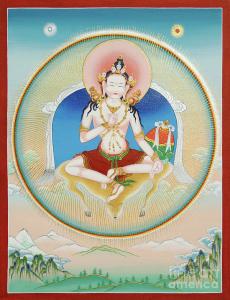Dakinis in the Life of Garab Dorje

Garab Dorje – The First Human Teacher of Dzogchen, painting by the extraordinarily talented Sergey Noskov.
Garab Dorje is considered the first human teacher of the Great Perfection (Dzogchen). The legend of his life is fascinating on several counts. One feature I have always found puzzling is why he meditated for thirty two years in the realm of the Hungry Ghosts. In Tibetan Buddhism, the realm of the Hungry Ghosts is a world full of insatiable hunger, thirst, obsession and suffering. It is considered one of the lower realms. It could have been any one of the realms, so why that one in particular? In a version of the past life of the Buddha, he first gave rise to bodhichitta in the hell realm. See my article that discusses this here – Pema Khandro’s Bodhisattva article. In any case, thirty two years alot of time spent in meditative stability anywhere, especially in the bad circumstances of the Hungry Ghost Realm, which only underscores how potent his meditative prowess was. But another fascinating thing about his life, is the role of the Dakini in his story.
A Dakini first appears in his life during when his mother, a nun, was meditating. She had a dream like vision of receiving a vase initiation and told her attendant about it. The attendant, who was named ‘Dakini,’ translated this dream to the nun. She told this nun that she would give birth to a nirmanakaya, a highly realized being. Later on after the nun did indeed have a child and she was terrified. Since she was a nun, she was afraid would people would think so she discarded the baby, leaving the baby in a pit of ashes. This is a really horrifying point in the story, but sadly, we can see themes of infanticide in many East Asian stories of this period. So she left the baby and ran away hoping no one would know. When she came back three days later, the baby was unharmed. She found that Dakini’s appeared in the sky making offerings to baby and thereby sustaining him.
This story is a useful example of the descriptions of Dakinis, because the first description before he was born is a human person, and the second one is more like an ethereal divine being appearing magically from the sky. This is how the Dakini is described in Tibetan Buddhism, it can be a term to describe highly realized human beings or it can be a term to describe divine or semi-divine beings and there are even ones that are monstrous as well. In Garab Dorje’s story, since offerings are being made to him by Dakinis as divine beings, this implies another sign that this was a realized being.
Dakinis appear in the story of Garab Dorje again when Garab Dorje put the teachings in writing. When it was time to write down 6,400,000 verses of esoteric Buddhist teachings, Dakinis appear again to help him. The Dakini of Immutable Space and the Dakini of Limitless Enlightened Qualities come to his aid as well as others. One Dakini is even placed in charge of holding the volumes of teachings, the Dakini Semdenma.
Later the first students to whom he teaches the Great Perfection (Dzogchen) to are – hundreds of thousands of Dakinis. Their mastery of the teachings is expressed in his legend by saying they all attained the rainbow body. The attainment of the rainbow body is how highly realized adepts are thought to die in the Great Perfection path. This also intimates that Garab Dorje’s first Dzogchen students were hundreds of thousands of human females, since the rainbow body is attained by human beings, not ethereal, divine or semi-divine dakinis, but human ones. However, we should be cautious in assuming that this literally infers the participation of actual females. This is a narrative, not a documentation of a literal history, but instead an aesthetic expression of a history of important Buddhist principles. Some Buddhists do take such stories literally of course, because Tibetan Buddhism is incredibly diverse in interpretation and practice. Diversity is beautiful. In any case, the presence of female students in such an important legend, even though it is not necessarily evidence of mass female participation, is a positive sign of the culture of the Great Perfection teachings. From its early era, the Great Perfection fostered a culture of relative inclusivity within non-celibate communities that did include female adepts.
So in the life of Garab Dorje – Dakinis prophesied his birth, took care of him when he was a stranded baby, helped in the recording of the teachings, help to preserve and protect the teachings, and Dakinis are the first students and first realizers of the teachings. We could even consider them ultimately as the first embodiments of the teaching (if rainbow body could be considered the ultimate form of embodiment in a context the body of light is considered the true body in Dzogchen).
About the Image
This image of Garab Dorje is a painting by Sergey Noskov. His are the most beautiful thangka paintings and it is possible to order prints. Among my favorites of his are the Ekajati and Longchenpa. See: https://fineartamerica.com/featured/garab-dorje-sergey-noskov.html?product=art-print
_______________________________
Author
Dakini Stories are written for the Dakini Mountain fundraiser by Pema Khandro. They are based on Tibetan Buddhist legends of Dakinis. Pema Khandro is a Buddhist teacher and scholar specializing in the traditions of Tibet’s Buddhist Yogis and their Great Perfection teachings. Learn more about Pema Khandro here: Pema Khandro Rinpoche
Sources
Khenpo, Nyoshul. Translator, Richard Barron. Marvelous Garland of Rare Gems: Biographies of Masters of Awareness in the Dzogchen Lineage. (Junction City: Padma Publishing, 2005). 37-38

